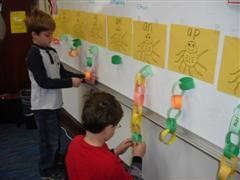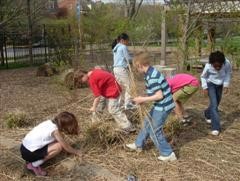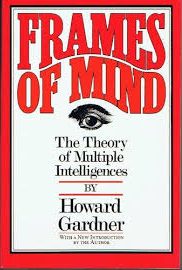
Multiple Intelligences Newsletter, Vol 30, No 2
September 20, 2020
Hi MI Friends,

These are crazy times. Who could imagine that we are encouraged to wear masks when entering a bank!?! It’s obvious that Covid is taking an emotional toll on everyone, adults and kids. I work with many teachers and administrtors in in my role at the University of Missouri-St. Louis (UMSL) and I know how hard everyone is working. Teachers and principals are spending more time now than before – and it’s mostly looking at a screen. Plus, success is more elusive. This is not a good combination for anyone!

So how does MI enter into this? Simple: Teaching through MI is a route to success. That doesn’t mean that everyone learns and it doesn’t mean that using MI is easy. It does mean that we learn best when we can use our strengths and, for sure, learning comes easier when we are engaged in the learning process.
I’m encouraged that the educational establishment is beginning to view students as more than stanines. That’s captured in the this article about college admissions. I’d be pleased to hear your reactions to it.

Congratulations to Howard Gardner! Gardner was recently honored by being awarded the 2020 Distinguished Contributions to Research in Education Award from AERA (The American Educational Research Association). You can read more about this prestigious award here.
Below you’ll find some MI pieces that I hope stir your mental juices and show why MI is so important. First, Seemantini Pathak shares a summary of her PhD dissertation, in which she draws upon the MI approach for an assignment on cultural experiences. From her abstract, she “explores how a multiple intelligences approach can be used to build a global mindset among students in online international management courses.” It’s a vivid reminder that MI can be a powerful tool to help students learn at every age and scholastic level. Only the abstract appears here, so contact Seemantini if you would like more information.
The second article is from Alan Cooper, a acclaimed educator from New Zealand. Alan ties the personal intelligences into “Deep Learning.” He always does a wonderful job of tying research to what works for students.
How are YOU doing? I’d be delighted to hear from you.
TOM
Thomas R. Hoerr, PhD
Emeritus Head of the New City School
Scholar In Residence at UM-St. Louis
ABSTRACT
This research explores how a multiple intelligences approach can be used to build a global mindset among students in online international management courses. It draws upon research in the areas of global mindset, education, cognition and learning, and neuroscience to discuss how pedagogical tools and strategies relevant to each specific intelligence can contribute to cognitive complexity and cosmopolitanism. Suggestions are offered for online teaching methods that can incorporate the multiple intelligences in international management courses.
Pathak, S. 2018. Encouraging Development of a Global Mindset among Students in Online International Management Courses. Journal of Teaching in International Business, 29(1): 20-48. https://www.tandfonline.com/doi/abs/10.1080/08975930.2018.1455920 Seemantini Pathak takes a Multiple Intelligences approach to teaching international management online at the university level. As we all adjust to teaching online all or much of the time, this paper offers ideas on using pedagogical tools that appeal to a variety of learning styles.
Seemantini Pathak is an Associate Professor of Management at the College of Business Administration at the University of Missouri – St. Louis. Her research interests include corporate governance in the context of strategic change, diversity in the firm’s board of directors, strategic human capital, and organizational learning. She has also carried out research on improving student learning. You can contact her at pathaks@umsl.edu, and read more about her here.
GROWING THE PERSONAL INTELLIGENCES: A STUDY IN DEEP LEARNING PRACTICES
by Alan Cooper
Introduction
When assessment is seen as learning-for students as well as for teachers-it becomes most informative and generative for students and teachers alike.
– Carol Ann Tomlinson
Deep learning is becoming a bandwagon term, poorly understood and therefore open to alternative definitions that are alternative facts, and therefore false. Deep learning about the student and the teacher understanding how meaning making, and the ability to transfer that meaning to another task is the basic process. The focus is on the know-how. Thus, the teachers’ role changes from that of a keeper of knowledge telling the students what they need to know, to that of a mentor or coach encouraging and developing student ownership. This ownership gives each student the freedom to pursue their individual goals and passions, the opportunity to reflect in order to self-assess/self-learn, and above all to engage the personal intelligences to become a scaffold on which to build quality. Crucially, assessment is in the hands of the students. In the example studied here, this resulted in each individual student developing a passion not only to improve, but a passion to achieve, that the students previously had not had.
Rubrics Provide a Detailed Learning Plan
It’s worth the time and energy to get organized now to save time and energy later.
-Monika Kristofferson
This was a performance music class preparing for their first individual performance of the year. Thus, they were novices. So, a practice field was required. Here, using a form of guided discovery with the teacher acting as a mentor/coach, not as an authority figure, but developing a class culture that promoted student voice in discovering the actions, the thinking and the doing associated with a Multiple Intelligences approach.
This started with a student discussion along the lines of brainstorming: no wrong answers an encouragement to be adventurous, innovative, imaginative, and to take responsible risks. After these initial discussions a copy of what had been drafted was placed on a wall chart for individuals and groups to add to or remove items as they reflected further. Thus, the rubric was not only an action plan but a living document continually growing in depth.
Negativity is played down in the rubric. A clear path forward is broadly indicated leaving the student to reflect and select what fits their needs. In performance skills “It doesn’t look as if I want to be there” invites the asking of the question, “How can I overcome this?” Likewise, in the musical skills there are also guides on what to reflect on, such as “I may be confused about the rhythm,” invites the question, “What do I need to know to get the rhythm right?”
Reflection
We do not learn from experience…We learn from reflecting on experience.
– John Dewey
The construction of the rubric introduced the students to reflection as a continuum. Reflection is creative problem solving. It is not an editorial exercise looking for the correct answer or an editorial task crossing t’s and dotting i’s. Instead it is searching for possible answers to give a choice of action in which to devise more sophisticated mental models.
A further class discussion, to decide the criteria for assessing individual students work. Resulted in presentation, research, and originality. The missing link was reflection, and this was added by the teacher. It was understood that all the Multiple Intelligences would be involved.
The students then entered more definitive guidelines for each of the eight intelligences to specifically focus these reflections. One example was this for the intrapersonal. “Thinking about how I work best and what I need help with. Asking myself organising questions. What shall I present? How shall I present it? What is relevant? What intelligences should I use to present the project? Am I making progress?”
As with the original rubric these charts were placed on the wall for ongoing reflection and additions between peers, interest groups, ability groups, and individuals. New concepts, new learning, new knowledge was being constructed which was sequential and incremental, as further development was built on the prior knowledge base discovered when the original rubric was formed.
To further aid the forming of reflective questions a brainstormed list was drawn up as a road map to guide the journey. Was the project worthwhile? Why/why not? What were some of the problems I/we encountered? (note the use of we and therefore the enlargement to other members of the class and even beyond). How did I/we solve these problems? What did I/we do well?
By now the students were coming to understand that they were providing the answers rather than the teacher. They were progressively more motivated to be active in their thinking and therefore self-reliant. The evidence comes from their teacher: “My classroom is humming, and students are discussing with each other the intelligences that they are using. They are thinking about the thinking they are engaged in (metacognition). This proves to me that the amount of time I had to take in setting up the work was worthwhile.” So, a given for the teacher is to make time to plan. Involving students in the ‘whole’ learning process, from creating the task to the final assessment provided a platform for greater student engagement, understanding and positive learning experiences.
So, a given for the teacher is, make time to plan not only for students but with them. Show them that you value their ideas and perspectives so that they are totally involved in all parts of the learning. Develop a classroom culture that builds on prior knowledge and experiences and that promotes active discussion amongst learners to further increase understanding. “Tell me and I forget, Teach me and I remember, Involve me and I learn” Benjamin Franklin
CONCLUSION: HOMEWORK
Even if you’re on the right track. You’ll get run over if you just sit there.
– Will Rogers
Do an audit of how this article has changed or is changing your personal intelligences and in so doing developing deeper learning/understanding. Use this window diagram recommended by Silver and McTighe as one note making visual format that encapsulates the elements of deep learning. The aim is to identify one simple straight forward core idea under each heading that is meaningful.
- FACTS
- FEELINGS & REACTIONS
- QUESTIONS
- CONNECTIONS
As many will be novices in this, included here are questions a mentor may ask.:
- Facts. Enter one substantial detail which can become an organising question.
- Feelings and Reactions. Include one preferably positive emotional response.
- Questions. Suggest a question that can be asked to aid planning
- Connections. How does this reveal the unexpected consequences of an experience, or what is one positive way this could be used in the future?
When you transfer this for another class keep it simple and manageable.
Alan can be reached at Alan Cooper 82napawine@gmail.com.
ASCD
This Professional Interest Community (PIC) is sponsored by ASCD as part of their effort to improve the quality of education for all children.
ASCD PICs are member-initiated groups designed to unite people around a common area of interest in the field of education. PICs allow participants to exchange ideas, share information, identify and solve problems, grow professionally, and establish collegial relationships.
You can learn about ASCD’s networks, publications, conferences, workshops, and the dialogues sponsored by ASCD at www.ascd.org. You can also register for the free, daily ASCD SmartBrief.
I’d like to hear from you! Please send me an email at trhoerr@newcityschool.org
